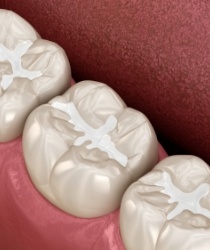Tooth-Colored Fillings
White Filling vs. Amalgam Fillings
 According to the ADA, the small amount of mercury in amalgam fillings bonds with other metals in the filling and renders it stable, and thus safe for filling teeth. Amalgams have not been banned in the US or elsewhere, and many dentists continue to use them regularly for restoring back teeth. So why are composite resin, porcelain, and ionomer (glass or resin) fillings replacing amalgams?
According to the ADA, the small amount of mercury in amalgam fillings bonds with other metals in the filling and renders it stable, and thus safe for filling teeth. Amalgams have not been banned in the US or elsewhere, and many dentists continue to use them regularly for restoring back teeth. So why are composite resin, porcelain, and ionomer (glass or resin) fillings replacing amalgams?
Beauty
Some dentists do not place amalgams, and many patients prefer tooth-colored composite, porcelain, or ionomer fillings to the silver of amalgams. An obvious reason is aesthetics. Made of metals, an amalgam stands out against naturally white teeth. When a person smiles, laughs, or speaks, amalgam fillings may show. Tooth-colored fillings matched to a patient’s natural tooth shade make the fillings blend seamlessly in a white, bright smile.
Strength
Composite fillings are bonded with adhesive to your tooth structure, protecting against decay and strengthening the tooth. This bond can make a composite filling last for seven to ten years, the same life expectancy of an amalgam filling. By contrast, dental amalgams do not form such a bond: they simply form a mechanical barrier to decay. Thus, over time, the amalgam-treated tooth can weaken, often creating a liability to your long-term dental health.
Protection
Composite fillings provide long-term bacterial invasion protection, too. Once bonded, a composite filling won't wear down or change shape, despite the incredible forces of biting and chewing. Bacteria and food particles cannot enter the tooth. However, silver amalgams on biting surfaces can change shape with biting and chewing impact. Tiny cracks in the material or between the filling and natural tooth structure can allow bacterial reinvasion, creating a bigger decay problem than you had at first.
Conservation
Conservative dentistry is a philosophy in which dentists preserve as much natural tooth structure as possible. Amalgam fillings require more reduction to the tooth – more removal of natural tooth structure – than composite resins. This means that if you want to maximize the amount of natural tooth structure in your mouth, amalgams may not be the right choice.
Moving Forward
Dental amalgams have been used in fillings for 100 years, but times change, and as dental medicine evolves, patients have more choices. These days, fillings made with metals, composites, porcelain, resin, or glass are common. As with all medical and dental procedures, you, as the patient, should stay informed about what’s available so that you can determine the best option for your unique case. If you have amalgam fillings but think composites are a better choice, your dentists can replace the amalgams. For more information, visit the ADA online at www.ada.org.
Dental Amalgams: Safe & Sound
Silver fillings have gotten a bad rap over the years. Typical rumors have it that silver amalgams' mercury content is connected to a host of health problems. Before choosing a less durable dental restoration material or rushing in to have your amalgams removed, do your teeth a favor: review the facts. Dental care experts, including the American Dental Associations, find silver amalgams to be an affordable, safe, and durable filling choice
How Safe are Amalgam Fillings?
Over the past 10 years, there's been talk of the possibility that intense chewing pressure might cause silver fillings to leak mercury vapors into the body. While an amalgam alloy contains approximately 43 to 54 percent of elemental liquid mercury, no proof supports the theory that mercury can leak or leach out of a filling. In fact, after more than 100 years of use and 10 years of extensive study and review by the FDA and US Public Health Service (USPHS), no scientific evidence shows that silver fillings cause health detriments, except in rare cases of allergy or hypersensitivity.
How Strong are Amalgam Fillings vs. Composite Resins?
Constant pounding and intense chewing pressure on biting surfaces can actually change an amalgam's shape, while the underlying tooth structure remains constant. This could cause cracks in the filling, cracks in the tooth, and invite bacterial invasion. However, should your dentist observe any danger of cracking, he can safely and successfully replace your fillings before they create a problem. On the other hand, composite resins are less durable than amalgams and often require earlier replacement.
The ADA deems amalgam fillings safe and sound, but your body is your responsibility, and you should know all the facts before making medical or dental decisions. For more information on dental amalgams and materials used in dental fillings, visit www.ada.org.
